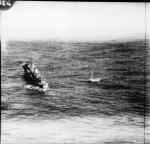World War II and the children's experience
The Mission
Imagine:
It is late September 1940. You are a young war reporter for a Canadian news service and just arrived in Liverpool, UK. You learned upon your arrival about a tragic event that took place earlier this month at sea. A large passenger ship headed to Canada, SS City of Benares, was torpedoed by a German submarine in the middle of the Atlantic ocean. The ship was part of a British convoy bound for the Canadian ports of Québec city and Montréal, under the command of Master Landles Nicoll. SS City of Benares was the flagship of the convoy.
The steam ship was carrying 407 passengers and crew members, including 90 child evacuees who were sent by their parents to Canada for safety and protection from bombs and war damage. In total, 260 of the 407 people on board were lost. This included 122 crew members and 134 passengers. Only 13 of the 90 child evacuee passengers survived.
Children had been selected by the Children's Overseas Reception Board (CORB) which was responsible for arranging the evacuation of British children. Some Allied countries, including Canada and the United States, volunteered to provide wartime homes and families to evacuees from Britain.
The tragedy took place on 17 September, 253 miles (400 km) southwest of Rockall islet in the Atlantic ocean. At 10:00 pm, German submarine U-48, under the command of Heinrich Bleichrodt, fired two torpedos at SS City of Benares which struck the flagship just below the cabins where the children were asleep in their bunks. Two children were killed instantly, and soon after the order was given to abandon the sinking ship.
It was a bitterly cold and windy night. Several lifeboats were smashed or capsized when they hit the stormy water. The rest of the convoy followed its course to Canada to avoid further damage. It was only the next day in the afternoon that the closest warship at sea, HMS Hurricane, arrived on the scene to rescue the survivors of the attack. One lifeboat drifted during the night and was left alone at sea for eight long days before being sighted and rescued by HMS Anthony. On board were 46 people: 37 crewmen, 6 children with two escorts, and one private passenger.
As a Canadian reporter in Europe, you realize that World War II spares no one, including civilians and children. So you decide to investigate this war time tragedy and write a story about war evacuees and the life of children who survived the sinking of SS City of Benares.
What was life like for children who experienced World War II?
The purpose of your mission is to use historical sources and the provided learning tools to study the experience of children during World War II, and in particular child evacuees on board SS City of Benares.
To achieve your mission you will have to imagine yourself in this period of world history and adopt the historical perspective of a Canadian journalist located in Europe. To learn more about your work, accept the mission and see the "Activities" section.
